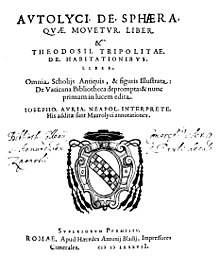피타네 오토리쿠스
Autolycus of Pitane피타네의 오토리쿠스(그리스어: αὐόόλλυςςςςς;;;;;;;;;;;;;;;;;;; c. 360~c. 290 BC)는 그리스의 천문학자, 수학자, 지리학자였다. 달 분화구 오토리쿠스는 그의 영예로 이름이 지어졌다.
삶과 일
오토리쿠스는 아시아 마이너 이오니아 내 아이올리스 마을 피타네에서 태어났다. 비록 그가 아리스토텔레스와 동시대의 사람이었고 그의 작품은 기원전 335년에서 300년 사이에 아테네에서 완성된 것처럼 보이지만 그의 사생활 중 아무것도 알려지지 않았다. 유클리드는 오토리쿠스의 작품 일부를 언급하고 있으며 오토리쿠스는 아르세실라오스를 가르친 것으로 알려져 있다. Autolycus' surviving works include a book on spheres entitled On the Moving Sphere (Περὶ κινουμένης σφαίρας) and another On Risings and Settings (Περὶ ἐπιτολῶν καὶ δύσεων) of celestial bodies. 오토리쿠스의 작품은 16세기에 마우로리쿠스에 의해 번역되었다.
움직이는 구에는 고대 그리스에서 온 수학적 논문 중 완전히 보존된 가장 오래된 것으로 여겨진다. 오토리쿠스 스피어 이전의 모든 그리스 수학적 작품들은 이후의 요약이나 해설, 작품 설명에서 따온 것이다.[1] 원래 9세기 아랍어로 번역해 보존한 '리틀 천문학'[2]이라는 널리 쓰이던 소장품의 일부였기 때문이다. 유럽에서는 분실되었으나, 12세기 십자군 전쟁 중에 다시 가져와 라틴어로 번역되었다.[3][4] 오토리쿠스는 그의 구에서 구의 특징과 움직임을 연구했다. 이 작품은 천문학자들이 필요로 할 구에 대한 기초적인 이론으로만 구성되어 있기 때문에 단순하고 정확하게 독창적인 것은 아니지만, 그 이론들은 분명히 발현되고 증명되었다. 그러므로 이것의 가장 큰 의의는 오늘날 고전 그리스 기하학의 전형으로 여겨지는 기하학에 철저하게 확립된 교과서적 전통이 그의 시대에 있었음을 보여주는 것이다. 정리문은 명확하게 발현되고, 그 증명과 함께 공사의 형상이 주어지며, 마지막으로 결론적인 발언이 이루어진다. 게다가, 그것은 그의 시대에 어떤 이론들이 잘 알려져 있었는지를 보여준다.[2] 200년 후 테오도시우스의 저서 '스파이리틱스'는 유덕수스가 쓴 어떤 유클리드 이전의 교과서에서 '움직이는 구 위에'와 공통된 기원을 가지고 있다고 여겨지는 책으로, 아마도 유덕수스가 쓴 책일 것이다.
천문학에서 오토라이커스는 '온 라이징과 설정'이라는 두 권의 책에서 그의 논문에서 천체의 상승과 설정 사이의 관계를 연구했다. 두 번째 책은 사실 그의 첫 번째 책의 확대판이며 더 높은 질의 것이다. 그는 "언제나 뜨고 지는 별은 지평선의 같은 지점에서 뜨고 지는 별"이라고 썼다. 오토리쿠스는 에우독수스의 천문학에 크게 의존했으며 에우독수스의 동족구 이론의 강력한 지지자였다.
각주
- ^ Boyer (1991). "The age of Plato and Aristotle". A History of Mathematics. p. 97.
A few years after Dinostratus and Menaechmus there flourished a mathematician who has the distinction of having written the oldest surviving Greek mathematical treatise. We have described rather fully the work of earlier Hellenic mathematicians, but it must be borne in mind that the accounts have been based no on original work but on later summaries, commentaries, or description. Occasionally a commentator appears to be copying from an original work extant at the time, as when Simplicius in the sixth century of our era is describing the quadrature of lines by Hippocrates. But not until we come to Autolycus of Pitane, a contemporary of Aristotle, do we find a Greek author one of whose works has survived.
- ^ a b Boyer (1991). "The age of Plato and Aristotle". A History of Mathematics. pp. 97–98.
One reason for the survival of little treatise, On the Moving Sphere, is that it formed a part of a collection, known as the "Little Astronomy," widely used by ancient astronomers. On the Moving Sphere is not a profound and probably not a very original work, for it includes little beyond elementary theorems on the geometry of the sphere that would be needed in astronomy. Its chief significance lies in the fact that it indicates that Greek geometry evidently had reached the form that we regard as typical of the classical age. Theorems are clearly enunciated and proved. Moreover, the author uses without proof or indication of source other theorems that he regards as well known; we conclude, therefore, that there was in Greece in his day, about 320 B.C., a thoroughly established textbook tradition in geometry.
- ^ "Theodosius of Bithynia". Retrieved 2 May 2015.
- ^ 비티니아의 테오도시우스
참조
| 위키소스는 1911년 브리태니커 백과사전 기사 "피타네의 오토리쿠스"의 원문을 가지고 있다. |
- Boyer, Carl B. (1991). A History of Mathematics (2nd ed.). John Wiley & Sons, Inc. ISBN 0-471-54397-7.
- Huxley, G. L. (1970). "Autolycus of Pitane". Dictionary of Scientific Biography. 1. New York: Charles Scribner's Sons. pp. 338–39. ISBN 0-684-10114-9. 에 줄서서.
- O'Connor, John J.; Robertson, Edmund F. (April 1999), "Autolycus of Pitane", MacTutor History of Mathematics archive, University of St Andrews



